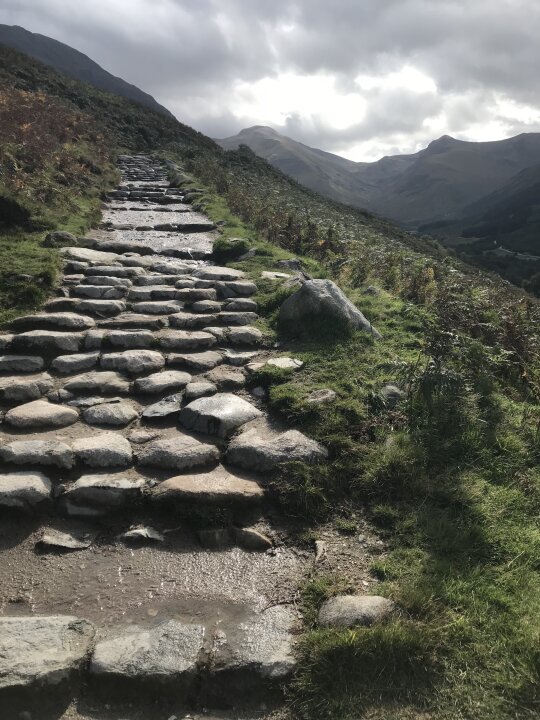I'm currently near Oban, Argyll, Scotland
Oban (Scottish Gaelic: An t-Òban meaning The Little Bay) is a resort town within the Argyll and Bute council area of Scotland. Despite its small size, it is the largest town between Helensburgh and Fort William. During the tourist season, the town can have a temporary population of up to over 24,000 people. Oban occupies a setting in the Firth of Lorn. The bay forms a near perfect horseshoe, protected by the island of Kerrera; and beyond Kerrera, the Isle of Mull. To the north, is the long low island of Lismore and the mountains of Morvern and Ardgour.
Humans have used the site where Oban now stands since at least Mesolithic times, as evidenced by archaeological remains of cave dwellers found in the town. Just outside the town, stands Dunollie Castle, on a site that overlooks the main entrance to the bay and has been fortified since the Bronze Age.
Just to the north of Oban, at Dunstaffnage, excavations in 2010, by Argyll Archaeology in advance of the development of the European Marine Science Park, found evidence that people were also living in the area from the Neolithic to the Early Historic periods. The archaeologists discovered funerary pyres that were in use for several generations during the Late Iron Age and a farmstead in use sometime between the late 7th to 9th centuries AD.
Prior to the 19th century, the town itself supported very few households, sustaining only minor fishing, trading, shipbuilding and quarrying industries, and a few hardy tourists. The Renfrew trading company established a storehouse there around 1714, as a local outlet for its merchandise, but a custom-house was not deemed necessary until 1736, with "Oban being reckoned a proper place for clearing out vessels for the herring fishery".
The modern town of Oban grew up around the distillery, which was founded there in 1794. A royal charter raised the town to a burgh of barony in 1811. Sir Walter Scott visited the area in 1814, the year in which he published his poem The Lord of the Isles; interest in the poem brought many new visitors to the town. The town was made a Parliamentary Burgh in 1833. A rail link – the Callander and Oban Railway – was authorised in 1864 but took years to reach the town. The final stretch of track to Oban opened on 30 June 1880. This brought further prosperity, revitalising local industry and giving new energy to tourism. Also at this time work on the ill-fated Oban Hydro commenced; the enterprise was abandoned and left to fall into disrepair after 1882 when Dr Orr, the scheme's originator, realised he had grossly underestimated its cost. Work on McCaig's Tower, a prominent local landmark, started in 1895. Paid for by John Stewart McCaig (1824–1902) the construction aimed, in hard times, to give work for local stonemasons. However, its construction ceased in 1902 on the death of its benefactor.
Built in 1897 for James Gemmel Boutein, Glencruitten House was built on the site of an earlier estate. Now Category B Listed, the building is a Scottish-style castle, or Scots Baronial house, that was significantly altered in 1903. A library wing was added in 1927/1928. The original architect, Edward Appin, was also involved in the work completed in 1903. Robert Lorimer of the Lorimer & Matthew firm, guided the additions made in the 1920s for Alexander Mackay, the owner at that time. The House has been a B-listed property since 1971. The contents were to be sold off by auction in 2003, including some furniture designed by Lorimer. Reports at that time shed additional light on the previous owners of the House, indicating that the MacKay family "at the Argyll house" had owned the property for four generations, since 1917 when it was acquired by "the venture capitalist Alexander MacKay"; the original owner was listed as the Shelly-Bonteyn family. MacKay and his son Robert Ferrier Burns Mackay were said to be significant collectors of art, including works by "Sir David Young Cameron (1865–1945) and James McBey (1883–1959)". For some time prior to 2020, Glencruitten House was owned by a religious community who listed it for sale that year. The listing for sale provided additional specifics: the House contained "woodwork and panelling believed to be by Clow Bros and Louis Davis stained glass windows. Also within the library is an original grade A listed Ingram organ with Welte Philharmonic roleplay mechanism (not fully operational)". The listing also stated that "remedial work [was] recently undertaken by the current owner".
During World War II (1939–1945) Merchant and Royal Navy ships used Oban as an important base in the Battle of the Atlantic. The Royal Navy had a signal station near Ganavan, and an anti-submarine indicator loop station, which detected any surface or submarine vessels between Oban, Mull and Lismore. There was a controlled minefield in the Sound of Kerrera, which was operated from a building near the caravan site at Gallanach. A Royal Air Force flying-boat base operated at Ganavan and on Kerrera, and an airfield at North Connel – built by the Royal Air Force. A Sector Operations Room was built near the airfield; after the war, this was extended to become the Royal Observer Corps Group HQ.
Oban was also important during the Cold War because the first Transatlantic Telephone Cable (TAT-1) came ashore at Gallanach Bay. This carried the Hot Line between the US Presidents and USSR General Secretaries. At North Connel, next to the airfield/airport was the NRC (Nuclear Reporting Cell) of the Royal Observer Corps (29 October 1925 to 31 December 1995).
Since the 1950s, the principal industry has remained tourism, though the town is also an important ferry port, acting as the hub for Caledonian MacBrayne ferries to many of the islands of the Inner and Outer Hebrides.
As with the rest of the British Isles, Oban experiences a maritime climate with cool summers and mild winters. The nearest official Met Office weather station for which online records are available is located at Dunstaffnage, about 2.7 miles (4.3 km) north-north-east of Oban town centre. Rainfall is high, but thanks to the Gulf Stream, the temperature seldom falls below 0 °C (32 °F).
Humans have used the site where Oban now stands since at least Mesolithic times, as evidenced by archaeological remains of cave dwellers found in the town. Just outside the town, stands Dunollie Castle, on a site that overlooks the main entrance to the bay and has been fortified since the Bronze Age.
Just to the north of Oban, at Dunstaffnage, excavations in 2010, by Argyll Archaeology in advance of the development of the European Marine Science Park, found evidence that people were also living in the area from the Neolithic to the Early Historic periods. The archaeologists discovered funerary pyres that were in use for several generations during the Late Iron Age and a farmstead in use sometime between the late 7th to 9th centuries AD.
Prior to the 19th century, the town itself supported very few households, sustaining only minor fishing, trading, shipbuilding and quarrying industries, and a few hardy tourists. The Renfrew trading company established a storehouse there around 1714, as a local outlet for its merchandise, but a custom-house was not deemed necessary until 1736, with "Oban being reckoned a proper place for clearing out vessels for the herring fishery".
The modern town of Oban grew up around the distillery, which was founded there in 1794. A royal charter raised the town to a burgh of barony in 1811. Sir Walter Scott visited the area in 1814, the year in which he published his poem The Lord of the Isles; interest in the poem brought many new visitors to the town. The town was made a Parliamentary Burgh in 1833. A rail link – the Callander and Oban Railway – was authorised in 1864 but took years to reach the town. The final stretch of track to Oban opened on 30 June 1880. This brought further prosperity, revitalising local industry and giving new energy to tourism. Also at this time work on the ill-fated Oban Hydro commenced; the enterprise was abandoned and left to fall into disrepair after 1882 when Dr Orr, the scheme's originator, realised he had grossly underestimated its cost. Work on McCaig's Tower, a prominent local landmark, started in 1895. Paid for by John Stewart McCaig (1824–1902) the construction aimed, in hard times, to give work for local stonemasons. However, its construction ceased in 1902 on the death of its benefactor.
Built in 1897 for James Gemmel Boutein, Glencruitten House was built on the site of an earlier estate. Now Category B Listed, the building is a Scottish-style castle, or Scots Baronial house, that was significantly altered in 1903. A library wing was added in 1927/1928. The original architect, Edward Appin, was also involved in the work completed in 1903. Robert Lorimer of the Lorimer & Matthew firm, guided the additions made in the 1920s for Alexander Mackay, the owner at that time. The House has been a B-listed property since 1971. The contents were to be sold off by auction in 2003, including some furniture designed by Lorimer. Reports at that time shed additional light on the previous owners of the House, indicating that the MacKay family "at the Argyll house" had owned the property for four generations, since 1917 when it was acquired by "the venture capitalist Alexander MacKay"; the original owner was listed as the Shelly-Bonteyn family. MacKay and his son Robert Ferrier Burns Mackay were said to be significant collectors of art, including works by "Sir David Young Cameron (1865–1945) and James McBey (1883–1959)". For some time prior to 2020, Glencruitten House was owned by a religious community who listed it for sale that year. The listing for sale provided additional specifics: the House contained "woodwork and panelling believed to be by Clow Bros and Louis Davis stained glass windows. Also within the library is an original grade A listed Ingram organ with Welte Philharmonic roleplay mechanism (not fully operational)". The listing also stated that "remedial work [was] recently undertaken by the current owner".
During World War II (1939–1945) Merchant and Royal Navy ships used Oban as an important base in the Battle of the Atlantic. The Royal Navy had a signal station near Ganavan, and an anti-submarine indicator loop station, which detected any surface or submarine vessels between Oban, Mull and Lismore. There was a controlled minefield in the Sound of Kerrera, which was operated from a building near the caravan site at Gallanach. A Royal Air Force flying-boat base operated at Ganavan and on Kerrera, and an airfield at North Connel – built by the Royal Air Force. A Sector Operations Room was built near the airfield; after the war, this was extended to become the Royal Observer Corps Group HQ.
Oban was also important during the Cold War because the first Transatlantic Telephone Cable (TAT-1) came ashore at Gallanach Bay. This carried the Hot Line between the US Presidents and USSR General Secretaries. At North Connel, next to the airfield/airport was the NRC (Nuclear Reporting Cell) of the Royal Observer Corps (29 October 1925 to 31 December 1995).
Since the 1950s, the principal industry has remained tourism, though the town is also an important ferry port, acting as the hub for Caledonian MacBrayne ferries to many of the islands of the Inner and Outer Hebrides.
As with the rest of the British Isles, Oban experiences a maritime climate with cool summers and mild winters. The nearest official Met Office weather station for which online records are available is located at Dunstaffnage, about 2.7 miles (4.3 km) north-north-east of Oban town centre. Rainfall is high, but thanks to the Gulf Stream, the temperature seldom falls below 0 °C (32 °F).











